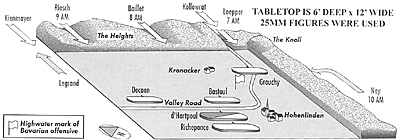 We considered doing a mini-campaign but time considerations ruled this out. So, we decided to begin the action at the historic time and place of contact, namely when the main Austrian column (Kollowrat) runs into the main French position (Grouchy). Having a fixed point of contact allowed us to build the necessary terrain. Jim set out the terrain boards according to the map and according to Ralph’s memory of the battlefield. When we were done it was very pleasing for Jim to hear Ralph comment that the terrain boards reflected the actual field of battle. (Thanks to the late Peter Gilder who introduced Jim to terrain boards.) When we were done, the table featured woods and rough terrain along the Austrian entry points with broad fields sweeping down to the French position along the valley road through Hohenlinden. The defiles from which the Austrians needed to emerge before coming to grips with the French played both an appropriate visual and gaming role.
We considered doing a mini-campaign but time considerations ruled this out. So, we decided to begin the action at the historic time and place of contact, namely when the main Austrian column (Kollowrat) runs into the main French position (Grouchy). Having a fixed point of contact allowed us to build the necessary terrain. Jim set out the terrain boards according to the map and according to Ralph’s memory of the battlefield. When we were done it was very pleasing for Jim to hear Ralph comment that the terrain boards reflected the actual field of battle. (Thanks to the late Peter Gilder who introduced Jim to terrain boards.) When we were done, the table featured woods and rough terrain along the Austrian entry points with broad fields sweeping down to the French position along the valley road through Hohenlinden. The defiles from which the Austrians needed to emerge before coming to grips with the French played both an appropriate visual and gaming role.
With Kollowrat and Grouchy fixed, we had about two-thirds of each army uncommitted and available for assignment according to each player’s pre-battle strategy. However, to reflect the historical situation we placed additional constraints on each side. Historically, the Austrians had nearly 16,000 men (FZM Michel Kienmayer’s column) on their northern flank. Claude Legrand’s division opposed Kienmayer.
In the historic battle, the size of Kienmayer’s column was one reason the French had to extend their forces to form a continuous line of battle in the Hohenlinden valley. In our game, Kienmayer and Legrand are “off board”. Kienmayer remains off board as long as Legrand also stays off board to check him and as long as the French keep Grouchy and two other divisions along the valley road. Kienmayer is “released” from “off board” if these conditions cease to prevail.
Thus the Austrian player has Kollowrat’s column beginning the battle in the south and Kienmayer off board to the north. In between are the columns commanded by FZM Johann Riesch and FZM Maximilien Baillet. Because of the poor road net, Weyrother assigned each column to separate roads and so must the Austrian player. Historically, although they tried to coordinate their marches, the rugged terrain and poor visibility impaired coordination between the columns.
To capture this essential aspect of the battle we created a semi-random order of appearance. Riesch and Baillet enter the board between 8 a.m and 10:30 a.m. according to a D6 roll. The Austrian player has three pips to reflect his staff effort to coordinate the columns. He assigns these pips to the D6 roll ahead of time. They will subtract three total from the die rolls. In our game Jim, who commanded the Austrians, gave all three to Riesch because this column was larger. He chose the northern entry point for Riesch and hoped that while Kollowrat worked against the French right Riesch would be able to gain ground against the French left and thereby open the way for Kienmayer to enter the table.
Historically, Antoine Richepance and Charles Decaen performed a battle-winning flank march and struck the Austrians in the left-rear. In our game, if the French commander (Ralph) sends a flanking column it appears on the southern table edge between 8 a.m. and 10 a.m. In 1800, Moreau ordered Richepance to strike the Austrian flank but told him that if unable to comply to march to Hohenlinden. To reflect this contingency, any French flanking force must also roll a die to see exactly where it appears.
Jim’s Napoleonic army features old-style 25mm figures mounted on battalion bases. The Austrians were the limiting factor. We counted everything in the Austrian collection and calculated that one base equaled 300 real soldiers.
Lastly, we needed victory conditions. Recall that Johann, full of youthful overconfidence, expected to perform a simple route march and brush aside the retreating French. Moreau wanted nothing less than to inflict a defeat that would drive the Austrians far back over the Inn River.
VICTORY CONDITIONS
- Major Austrian Victory: Austrians have two columns controlling valley road sections by sunset.
Minor Austrian Victory: One column controlling valley road.
Draw: Austrians keep the heights clear of all French divisions.
Minor French Victory: One division on heights
Major French Victory: Three divisions on heights.
More Battle of Hohenlinden A Napoleonic Refight
-
Introduction and Historical Background
Converting Historical Battle to Tabletop Simulation
Battle Plans, Rules, and Refight
French Order of Battle
Austrian order of Battle
Large Map (slow: 129K)
Jumbo Map (extremely slow: 319K)
Back to Table of Contents -- Courier # 83
To Courier List of Issues
To MagWeb Master Magazine List
© Copyright 2002 by The Courier Publishing Company.
This article appears in MagWeb (Magazine Web) on the Internet World Wide Web.
Other military history articles and gaming articles are available at http://www.magweb.com